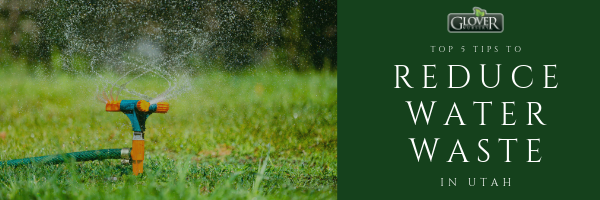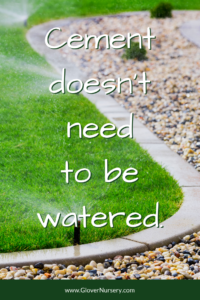Don’t Water More, Water Smart
 Glover Nursery’s Top 5 Water Saving Tips to Reduce Water Waste
Glover Nursery’s Top 5 Water Saving Tips to Reduce Water Waste
Summer is here and that means so is the heat. We get a lot of people wanting to reduce wasted water, which is awesome. We have five easy water saving tips for you. Don’t be nervous about depriving your much-loved plants and potentially causing them harm. Our top 5 tips to help save water will have both your water bill and your plants happy.
There are many small adjustments that add up to significant progress for water conservation. Some big tasks like installing a drip system may be more of a long-term goal project. However, there are also many small things you can do today to make a large difference in saving water.
Helping our water supply while saving money on your water bill…that’s the goal. AND, extra bonus, you’ll be giving your plants the best possible support. Many of these recommendations are actually the best thing for your plants. That’s like winning the plant lottery and water lottery at the same time! Here are our top 5 ways to help you save water.
1. Water Early
 Water your lawn early in the morning, between 4-7am. When we water lawns in the middle of the day, the majority of that water goes straight into the air and evaporates before it ever hits your lawn. Many sprinkler heads turn water into tiny drops and those tiny drops evaporate fast in the heat.
Water your lawn early in the morning, between 4-7am. When we water lawns in the middle of the day, the majority of that water goes straight into the air and evaporates before it ever hits your lawn. Many sprinkler heads turn water into tiny drops and those tiny drops evaporate fast in the heat.
When you water before the air is hot more of the water will actually reach the lawn, and therefore the roots, where the water is needed. The result, less time is needed to water and therefore less water is used (and wasted). For more lawn specific ideas, check our last blog post, Summer Lawn Tips.
2. Check Your Sprinkler System
Your sprinkler system can be adjusted to work smarter. You can make quick changes to your sprinkler system like correct where the heads spray, adjust clocks throughout the year as seasons change and make sure none of the lines are broken. These quick changes will  save hundreds of gallons of water in one season. The simple things can really add up! Monitoring your sprinkler system is the simplest way to start.
save hundreds of gallons of water in one season. The simple things can really add up! Monitoring your sprinkler system is the simplest way to start.
Some quick questions to ask yourself:
-
What season is it?
- Less water is needed in spring and fall.
-
Is it Raining?
- If it’s raining, turn off the system entirely.
- Rain sensors are available at local stores. They can be hooked up to your system to make this even easier.
-
Did you split the cycle?
- Avoid unnecessary water runoff by splitting a cycle. This trick allows water to absorb deeper into the soil.
- If your system is set to run a 40-minute cycle, do 20 minutes, wait for 10, run another 20 minutes.
- This simple adjustment can eliminate the need for an entire cycle once a week.
A great resource for other sprinkler related recommendations to reduce water waste can be found at scienTurfic Sod.
3. Water Low
Water at the base of your trees, shrubs, and perennials to save water. Spraying the leaves and trunks can actually cause damage in the heat. Plus, it doesn’t solve the problem of the water reaching the roots where it is needed.
New Plants
 It is extremely important to deep soak new plants during their establishment phase. To deep soak new plants, turn your hose to a very slow trickle. Place the hose about 4-6” from the base of the stem or trunk of your new plant. The length of watering time needed depends on the size of the root ball. For smaller 1-5 gallon size plants, 10-15 minutes twice a week should be sufficient. For larger trees and shrubs, we recommend 10 minutes per inch caliper on the tree (i.e. a large 4” caliper tree requires 40 minutes of soaking).
It is extremely important to deep soak new plants during their establishment phase. To deep soak new plants, turn your hose to a very slow trickle. Place the hose about 4-6” from the base of the stem or trunk of your new plant. The length of watering time needed depends on the size of the root ball. For smaller 1-5 gallon size plants, 10-15 minutes twice a week should be sufficient. For larger trees and shrubs, we recommend 10 minutes per inch caliper on the tree (i.e. a large 4” caliper tree requires 40 minutes of soaking).
Established Plants
Established plants are plants that have been in your landscape for a year or more. Two years or more for larger trees. We recommend installing a drip system or micro-emitter. The benefit of these systems is there is zero water waste. All of the water is put directly into the soil where it is needed. These systems emit water at such a slow rate that the water absorbs deeper and deeper into the soil. Achieving our ultimate goal, getting the water to those grounding roots.
By watering your plants directly at the roots you will:
- Put the water exactly where it is needed.
- Help to establish deeper, stronger roots.
- Waste very little, if any, water as it is going directly to the area needed.
4 . Don’t water wet soil.
This might seem obvious, but if your soil is still wet from previous watering it likely can wait another day or two. This includes rain-storms. The recommended way to check if your soil is wet is what my grampa called “the finger test”. It is a very simple water saving test. Stick your finger in the soil up to your second knuckle. If you feel moisture, no need to water. This simple check will save you hundreds of gallons of water waste.
5 . Know your soil type.
Clay soil holds more water, sandy soil dries faster. If you have more clay base, you do not need to water as often. Clay base soils do need to be watered deeper.
Sandy soil needs less watering at any given time. But it will need slightly more frequent watering. Knowing your soil type will save you water, time, money and hassle. And, your plants will thrive when you combine proper watering technique with the appropriate soil type.
There are loads more ways you can reduce, or even eliminate, water waste. looking for even more ideas to help save water? There are wonderful local resources available. Check out some of the following.
- Utah Division of Water Resources
- Conservation Garden Park
- Red Butte Gardens
- Or, you can check out this fun link by HGTV
If you have any great tips that you don’t see, let us know! There are probably loads of great water-saving inventions out there we haven’t seen yet and would love to share. After all, when it comes to reducing water waste, we are all in it together.
